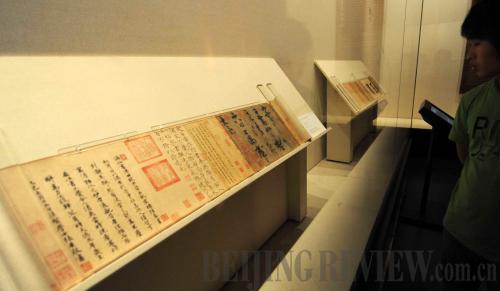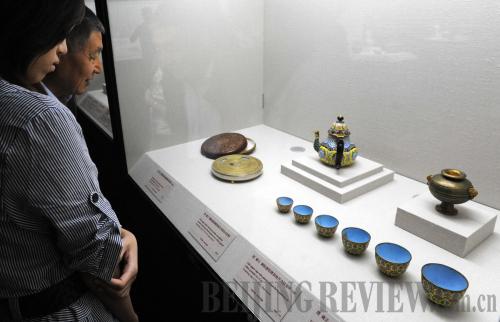|
Ceramic secrets
The Palace of Prolonging Happiness used to be the sleeping chamber of Qing Dynasty concubines. Today, though, it is home to the research laboratory of ancient ceramics.
 |
|
PRECIOUS ARTS: Beijing's Palace Museum visitors view calligraphic works from Li Bai, a famous poet during the Tang Dynasty (618-907) (XINHUA) |
The laboratory contains advanced materials analysis and detection instruments, which researchers use to detect the sizes of ancient ceramics' atoms and molecules.
Laboratory Director Miao Jianmin said composition analysis helps more accurately identify ancient ceramics along with providing information to reproduce forgotten ceramic-firing techniques.
The Taipei palace museum has more than 25,000 ceramics, hailing from the five well-known kilns of the Song Dynasty (960-1279), as well as governmental kilns of the Ming (1368-1644) and Qing dynasties. Among those are more than 300 so-called Chinese peak ceramics with baked enamel colors from the Kangxi (1654-1722) and Yongzheng reigns of the Qing Dynasty.
 |
|
FASCINATING DISPLAY: Taipei palace museum visitors appreciate a set of enamelled porcelain tea pots and cups from the reign of Emperor Yongzheng during the Qing Dynasty (WU JINGTENG) |
The Taipei museum bought advanced detection instruments to ascertain the secrets of ancient firing techniques.
"Enamel technology was monopolized by the Qing Dynasty government and gradually disappeared. Today, research into the lost technology is one of the key research topics at the Taipei museum," Chen said.
In the Beijing museum's laboratory, Chen and other researchers probe antique pottery samples to study their components and molecular structures.
"Although the samples include only some small fragments, they can present rich information using spectroscopy, such as ceramic raw materials and firing techniques," Chen said.
Conserving time
The Beijing museum has more than 1,500 imperial clocks but only three conservators. Qin Shiming, a clock conservator at the institution, said their clocks were mainly manufactured between the 18th and early 20th centuries and include representative works from the Western Industrial Revolution in Britain, France and Switzerland and those made by Qing Dynasty imperial workshops.
As the toys of emperors, imperial clocks were fashioned to perform many complex movements, including acrobatics, magic arts and music, Qin said. The clocks' hearts are made of complicated machinery.
"One such clock has several transmission systems and each system has many components so it is very difficult to fully understand their complete functionality," said Chen.
Clock conservation is a kind of traditional skill relying upon conservators' experience and faculty of memory.
Sixty-three-year-old Qin has worked in the Beijing museum for 35 years and has accumulated a great deal of knowledge on their conservation. Under his direction, Chen has begun to grasp conservation techniques.
There is a machine bird installed in one of the clocks. Pointing to it, Chen said he had spent a lot of time to understand how its wings work and how to make it sing.
"I'm happy I fixed it finally," he said.
Besides learning conservation skills, Chen is also sketching the detailed processes of clock conservation, recording them and drawing their inner mechanical structures.
"These data and pictures will be helpful for the public to understand the history of early technical development," he said. | 